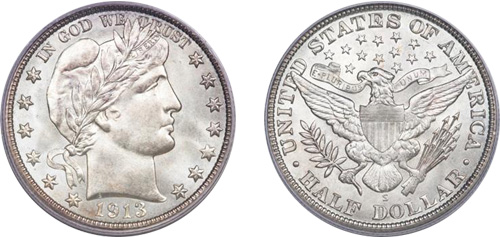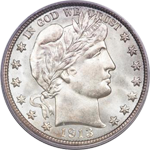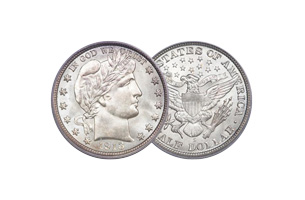Struck between 1892 and 1915, Barber half dollars enjoyed pretty steady production. As is true with other Barber denominations, collectors who seek to collect the entire series should be able to complete the set, especially if they don’t mind lower grade coins. However, some issues in higher grades or in certain varieties may be expensive and hard to obtain. Some highly desired specimens in the series include the Micro O 1892-O, any 1892-O, and the 1892-S Barber half dollars.
In the late 19th century, Mint Director James P. Kimball wanted to hold a contest to select an artist to design new silver coins. Until then, the Seated Liberty coinage had been in circulation for more than 50 years. In 1890, the U.S. Treasury invited ten artists to submit their designs for the half dollar, quarter, and dime. Among them was Augustus Saint-Gaudens, the country’s most prominent sculptor. However, the artists got together and drafted as set of terms prior to the competition. They demanded $100 for their sketches and an additional $500 for each model submitted. Unwilling to comply, the Treasury instead turned to their Chief Engraver, Charles Barber, who had wanted to undertake this project all along.

The obverse features Barber’s the profile of Lady Liberty. She faces to the right and wears a laurel crown. Thirteen stars circle her head along the edge of the coin, and the motto of IN GOD WE TRUST is struck above her head. The mint date is found below the head. Some people informally refer to coins in this series as Barber Heads, due to the prominence of that particular feature in the design.
The design of the reverse side also includes 13 stars, which are found over the heraldic eagle’s head. The inscription UNITED STATES OF AMERICA is engraved along the top edge of the coin, while the denomination HALF DOLLAR located across the bottom edge. The eagle holds an olive branch in one talon and arrows in the other. Furthermore, the eagle is holding a ribbon in its beak with the U.S. seal motto E PLURIBUS UNUM.
The coins were struck at U.S. Mint branches in Denver, New Orleans, San Francisco, and Philadelphia. The respective mintmarks are D, O, S, and no mark, and can be found below the tail of the eagle on the reverse.
All Barber half dollars contain 90% silver and 10% copper.
Compared to other coins produced by the U.S. Mint, Barber coins are usually considered simple and somewhat plain. Yet, it is important to note that Barber was not just a coin designer, he was also the Mint’s Chief Engraver. As such, he felt that part of his job was to make his designs economical and fast to produce. Consequently, all three coins were introduced in 1892. While yearly production of the Barber half dollar never dropped below 100,000, it also never exceeded 6 million at any given mint. The high point was reached in 1899 at the Philadelphia mint with just over 5.5 million half dollars being struck, whereas the low point occurred in 1914 with barely 125,000 half dollars being produced at the same mint branch.
PCGS 1, a coin-grading service, estimates that a complete set by date and mintmark of circulated coins could be worth about $3,000. However, that same set in high grades could be valued from around $500,000 to just under a million dollars. Collecting a circulated set could be a reasonable goal for most collectors, but collecting that same set in a high grade would be more like seeking a treasure. Regardless of mint state and population number, these are still silver coins that have intrinsic and historical value, thus presenting a great opportunity for precious metal collectors and investors alike.


